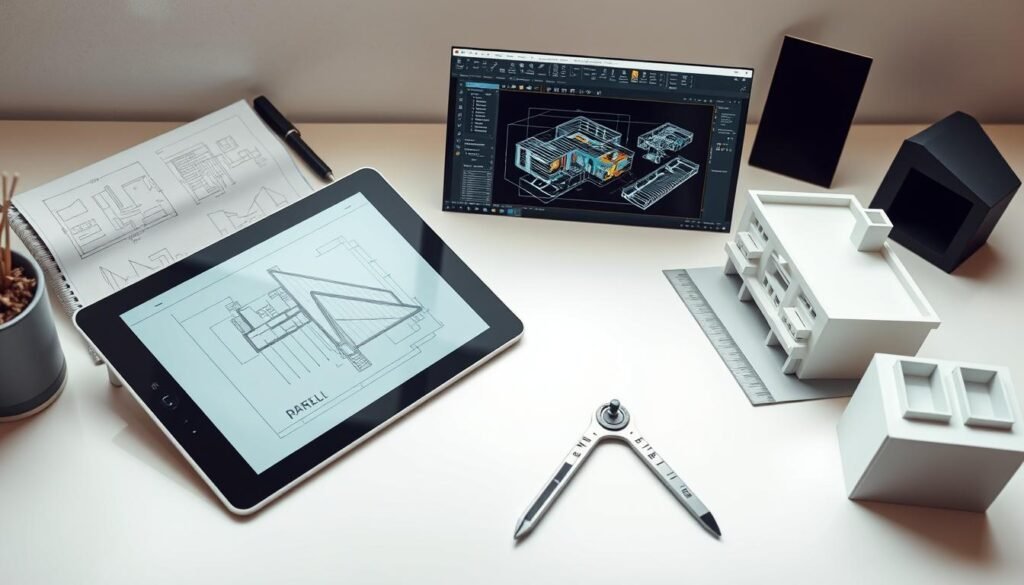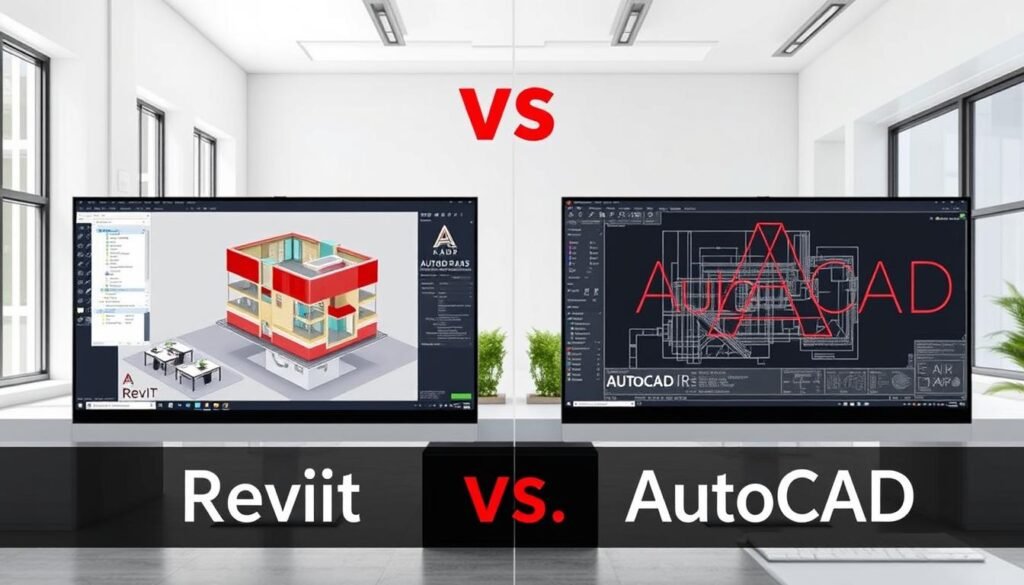The architectural industry is rapidly evolving, with technology playing a crucial role in this transformation. Despite the advancements, many architectural firms continue to rely on CAD software, which is now considered outdated.
Using CAD has its drawbacks, particularly in complex projects that require precision and collaboration. The limitations of CAD become apparent when compared to modern design software like BIM, which offers enhanced collaboration tools and more accurate project visualizations.
Upgrading to newer design technologies can significantly improve an architectural firm’s efficiency and competitiveness. By adopting modern design software, firms can enhance their collaboration, reduce errors, and deliver projects more efficiently.
Key Takeaways
- Architectural firms using CAD are at a competitive disadvantage.
- Modern design software like BIM offers significant improvements over CAD.
- Upgrading technology can enhance collaboration and reduce project errors.
- Firms that adopt new technologies are more likely to deliver projects efficiently.
- Staying updated with the latest design software is crucial for success in the architectural industry.
The Current State of Architectural Design Technology
The architectural design landscape is undergoing a significant transformation with the advent of new technologies. This shift is not just about adopting new tools, but also about changing the way architects work, collaborate, and deliver projects.
Evolution from Drawing Boards to Digital Design
The journey from traditional drawing boards to digital design has been remarkable. Initially, Computer-Aided Design (CAD) software revolutionized the industry by providing a digital alternative to manual drafting. However, the introduction of Building Information Modeling (BIM) has taken this a step further by enabling architects to create detailed, data-rich models.

Market Distribution: CAD vs BIM Usage Statistics
The architectural design software market is divided between CAD and BIM technologies. According to recent statistics, the distribution is as follows:
| Software Type | Usage Percentage |
|---|---|
| CAD | 55% |
| BIM | 45% |
The Technology Gap in Modern Architecture
Despite the advancements, there is a noticeable technology gap in modern architecture. Firms still using CAD are finding it challenging to keep up with the demands of complex projects and collaborative workflows that BIM offers. BIM training for architects is becoming essential to bridge this gap and stay competitive.
As the industry continues to evolve, understanding the current state of architectural design technology is crucial for firms looking to adopt the latest tools and methodologies.
AutoCAD Limitations in Architecture: Why Traditional CAD Falls Short
As architectural projects become more complex, the limitations of AutoCAD in handling 3D designs and collaborative work are becoming apparent. While AutoCAD has been a cornerstone in architectural design, its traditional CAD approach is now facing significant challenges in meeting the evolving demands of modern architecture.
2D Constraints in a 3D World
AutoCAD’s roots in 2D drafting have made it less adept at handling the complexities of 3D modeling and the data-rich environments that modern architectural projects require. This limitation can lead to inefficiencies in design and coordination.
The shift towards 3D modeling and Building Information Modeling (BIM) has highlighted AutoCAD’s shortcomings in these areas. As projects become more intricate, the need for a more integrated and data-driven approach becomes critical.
Inefficient Collaboration Capabilities
Collaboration is a crucial aspect of architectural projects, and AutoCAD’s traditional CAD approach often falls short in facilitating real-time collaboration and data sharing. This can result in misunderstandings, errors, and delays.
Real-time collaboration is essential for the success of modern architectural projects. The inability of AutoCAD to efficiently support this can hinder project progress and impact overall quality.
Documentation and Revision Challenges
Documentation and revision management are critical components of architectural projects. AutoCAD’s limitations in these areas can lead to significant challenges, including error-prone manual coordination and time-consuming drawing updates.
Error-Prone Manual Coordination
Manual coordination between different stakeholders and disciplines can be fraught with errors when relying on traditional CAD methods. A single miscommunication can lead to costly revisions.
Time-Consuming Drawing Updates
Updating drawings manually is not only time-consuming but also prone to errors. As projects evolve, the need for frequent updates can significantly slow down the design process.

| Feature | AutoCAD | Revit |
|---|---|---|
| 3D Modeling Capabilities | Limited | Advanced |
| Collaboration Features | Inefficient | Real-time |
| Documentation Management | Manual, Error-Prone | Automated, Integrated |
The table above highlights some of the key differences between AutoCAD and Revit, particularly in areas where AutoCAD falls short. As the architectural landscape continues to evolve, the limitations of traditional CAD software like AutoCAD become more pronounced, making a strong case for adopting more advanced and integrated solutions like Revit.
The BIM Revolution: What Modern Architectural Firms Are Gaining
As the construction industry evolves, BIM stands out as a key driver of innovation for architectural firms. The adoption of Building Information Modeling is transforming the landscape of architectural design, offering numerous benefits that traditional CAD systems cannot match.
Integrated Building Information Modeling
At the heart of the BIM revolution is its ability to integrate various aspects of building design into a single, coherent model. This integrated approach allows architects to create detailed digital representations of buildings, incorporating not just geometric data but also information about materials, components, and systems.
Real-time Collaboration Benefits
BIM facilitates real-time collaboration among architects, engineers, contractors, and clients. By working on a shared model, stakeholders can identify and resolve potential issues early in the design process, reducing errors and improving project outcomes.
Data-Rich Design Environment
A significant advantage of BIM is its ability to create a data-rich design environment. This enables architects to analyze various aspects of building performance, from energy efficiency to structural integrity.
Parametric Modeling Advantages
Parametric modeling, a key feature of BIM, allows architects to define relationships between different elements of a building model. This enables automatic updates when changes are made, streamlining the design process and reducing the risk of errors.
Sustainability Analysis Capabilities
BIM tools, such as those provided in Revit, offer advanced sustainability analysis capabilities. Architects can use these features to assess the environmental impact of their designs, optimizing for energy efficiency, daylighting, and other sustainability factors. For firms looking to enhance their BIM skills, revit training for architectural practices is essential.
The BIM revolution is not just about adopting new technology; it’s about transforming the way architectural firms work. By embracing BIM, firms can improve collaboration, enhance design quality, and gain a competitive edge in the market. As the industry continues to evolve, bim training for architects will become increasingly important for staying ahead of the curve.
Revit vs AutoCAD: A Comprehensive Comparison for Architectural Design
In the realm of architectural design, the choice between Revit and AutoCAD can significantly impact project outcomes. Both software tools have their strengths and are suited for different aspects of architectural work.
Core Functionality Differences
Revit is built around Building Information Modeling (BIM) technology, which allows for the creation of intelligent 3D models that contain both geometric and non-geometric data. AutoCAD, on the other hand, is primarily a 2D drafting tool, although it has evolved to include 3D modeling capabilities.
Revit is ideal for projects that require detailed building information modeling, enabling architects to explore design concepts and analyze building performance. In contrast, AutoCAD remains a versatile tool for drafting and detailing.
Project Lifecycle Management
Revit’s BIM capabilities facilitate comprehensive project lifecycle management, from conceptual design through construction documentation and beyond. AutoCAD, while useful for drafting, does not inherently support the same level of lifecycle management as Revit.
“BIM has revolutionized the way we design and manage projects, offering a more integrated and efficient process.” – Autodesk
Workflow Efficiency Improvements
Revit’s integrated design environment allows for real-time collaboration and reduces the need for redundant data entry, improving workflow efficiency. AutoCAD’s traditional 2D drafting approach can lead to data fragmentation and increased manual labor.
Cost-Benefit Analysis
| Feature | Revit | AutoCAD |
|---|---|---|
| BIM Capabilities | Advanced | Limited |
| 3D Modeling | Integrated | Available |
| Collaboration Tools | Real-time | Traditional |
| Cost | Higher | Lower |
While Revit offers advanced BIM capabilities and improved collaboration, its cost is generally higher than AutoCAD. The choice between the two should be based on the specific needs and goals of the architectural project.
The Competitive Edge: How BIM Enhances Client Relationships
As architectural firms continue to evolve, BIM stands out as a critical tool for strengthening client relationships through better communication and visualization. By adopting BIM, firms can significantly improve their competitive edge in the market.
Enhanced Visualization and Client Communication
BIM technology allows for more immersive and interactive visualizations, enabling clients to better understand the design intent and make more informed decisions throughout the project lifecycle. This enhanced visualization capability fosters a more collaborative environment, improving overall client satisfaction.
Faster Project Delivery Timelines
With BIM, architectural firms can streamline their workflows, reducing the time required for project delivery. This efficiency is achieved through automated processes and real-time collaboration, allowing firms to meet tight deadlines without compromising on quality.
Improved Accuracy and Reduced Errors
The data-rich environment of BIM minimizes the risk of errors and inaccuracies, which are common in traditional CAD systems. By leveraging BIM, firms can ensure higher accuracy in their designs, reducing the need for costly revisions and enhancing client trust.
Marketing Advantage of Advanced Design Capabilities
Adopting BIM not only improves internal processes but also serves as a marketing differentiator for architectural firms. By showcasing their ability to deliver complex projects with precision and efficiency, firms can attract new clients and retain existing ones, ultimately driving business growth.
In conclusion, BIM offers architectural firms a multifaceted approach to enhancing client relationships, from improved visualization and faster project delivery to reduced errors and a marketing advantage. By embracing BIM, firms can position themselves at the forefront of the industry, ready to meet the evolving needs of their clients.
Revit Training for Architectural Practices: Overcoming the Learning Curve
The shift towards BIM has made Revit training a critical component for architectural firms looking to modernize their design processes. As the industry continues to evolve, the need for skilled professionals who can effectively utilize Revit has become increasingly important.
Structured Training Programs and Certification Paths
Structured training programs are essential for architectural practices looking to adopt Revit. Autodesk, the developer of Revit, offers various certification paths that validate a user’s proficiency in the software. These programs range from beginner to advanced levels, ensuring that users can develop the skills needed to tackle complex projects.
- Autodesk Authorized Training Centers (ATCs) provide instructor-led training.
- Online courses and tutorials are available for self-paced learning.
- Certification exams help demonstrate expertise to clients and employers.
Resources for Self-Learning and Skill Development
For those who prefer self-learning, there are numerous resources available. Online forums, tutorials, and YouTube channels dedicated to Revit offer a wealth of information. Additionally, Revit user’s groups can be a valuable resource for networking and learning from peers.
| Resource Type | Description | Benefit |
|---|---|---|
| Online Tutorials | Step-by-step guides on using Revit features. | Flexible learning at your own pace. |
| User Communities | Forums and groups where users share knowledge. | Networking and problem-solving. |
| Certification Programs | Official certification from Autodesk. | Enhanced credibility and career opportunities. |
Mentorship and Community Support
Mentorship plays a crucial role in the learning process. Experienced professionals can guide newer users through the complexities of Revit, providing valuable insights and tips. Community support through online forums and local user groups can also be instrumental in overcoming challenges.
Internal Knowledge Transfer Strategies
Architectural firms can benefit from implementing internal knowledge transfer strategies. This includes pairing less experienced staff with those who have more Revit experience, creating an internal mentorship program.
Leveraging Online Communities and Forums
Online communities and forums are a great resource for Revit users. These platforms allow users to ask questions, share tips, and learn from others who may have encountered similar challenges.
By investing in Revit training and leveraging available resources, architectural practices can ensure a smooth transition to BIM, enhancing their design capabilities and staying competitive in the industry.
Implementing BIM: Transition Strategies for CAD-Based Firms
Implementing BIM is a significant step for architectural firms moving away from traditional CAD. This transition can be complex, but with the right strategies, firms can leverage BIM to enhance their design capabilities and stay competitive.
Phased Implementation Approaches
A phased implementation approach allows firms to gradually transition from CAD to BIM, minimizing disruption to ongoing projects. This can start with:
- Identifying pilot projects to test BIM workflows
- Training a core team in BIM design software for architects
- Gradually scaling up BIM adoption across the firm
Managing Team Resistance to Change
Resistance to change is common when introducing new architectural design tools. To manage this, firms should:
- Communicate the benefits of BIM clearly to all team members
- Provide comprehensive training and support
- Involve team members in the transition process to garner feedback and buy-in
Hybrid Workflows During Transition
During the transition period, maintaining hybrid workflows that support both CAD and BIM is crucial. This allows firms to:
- Continue working on CAD projects while developing BIM capabilities
- Collaborate with clients and consultants who may still be using CAD
- Ensure a smooth handover of projects from CAD to BIM
Hardware and Infrastructure Considerations
Upgrading to BIM often requires improvements in hardware and infrastructure. Key considerations include:
- Upgrading computer hardware to handle BIM software demands
- Enhancing network infrastructure for better data management and collaboration
- Investing in cloud storage solutions for project data
By adopting a phased approach, managing team resistance, maintaining hybrid workflows, and upgrading hardware and infrastructure, CAD-based firms can successfully transition to BIM. This transition not only enhances their design software for architects capabilities but also positions them for future growth and competitiveness in the architectural design industry.
ROI Analysis: The Business Case for Upgrading from CAD to BIM
As architectural design technology evolves, the transition from CAD to BIM has become a critical consideration for firms looking to stay competitive. The return on investment (ROI) for upgrading to BIM is multifaceted, involving both short-term investments and long-term gains.
Short-term Investment vs Long-term Gains
Initially, the cost of implementing BIM technology can seem daunting, including software costs, training, and potential downtime. However, the long-term benefits far outweigh these initial expenses. Firms that have made the switch report significant improvements in productivity and project delivery times.
A notable example is a mid-sized architectural firm that transitioned from CAD to BIM and saw a 30% reduction in project delivery time within the first year. This improvement directly translates to increased client satisfaction and the ability to take on more projects.
Case Studies: Firms That Successfully Transitioned
Several architectural firms have successfully transitioned from CAD to BIM, achieving remarkable results. For instance, a large firm in the United States reported a 25% increase in client retention after adopting BIM, attributed to enhanced visualization and communication capabilities.
“BIM has revolutionized our design process, allowing us to deliver projects more efficiently and effectively. The initial investment was worth it.” –
Measuring Productivity Improvements
Productivity improvements are a key metric for measuring the success of BIM adoption. By streamlining workflows and reducing errors, firms can significantly enhance their overall productivity.
| Metric | CAD | BIM |
|---|---|---|
| Project Delivery Time | 100 days | 70 days |
| Error Rate | 5% | 2% |
| Client Satisfaction | 80% | 95% |
Client Retention and New Business Acquisition
The adoption of BIM not only aids in client retention but also serves as a competitive advantage in acquiring new business. Firms that offer BIM services are seen as more innovative and capable of handling complex projects.
By upgrading from CAD to BIM, architectural firms can significantly improve their workflow, client satisfaction, and overall competitiveness in the market. The ROI analysis clearly indicates that the long-term benefits of BIM adoption far outweigh the initial investment costs.
Conclusion: Embracing the Future of Architectural Design
As the architectural landscape continues to evolve, firms still relying on traditional CAD software are facing significant challenges. Understanding the autocad limitations in architecture is crucial for making informed decisions about design technology upgrades.
By transitioning to BIM and Revit, architectural practices can overcome the constraints of 2D design and inefficient collaboration. Effective revit training for architectural practices is essential for maximizing the benefits of this powerful technology.
Firms that embrace the future of architectural design will be better positioned to deliver complex projects efficiently, improve client relationships, and stay competitive in a rapidly changing market.
By investing in the right design technologies and training, architectural firms can unlock new opportunities for growth and success.

